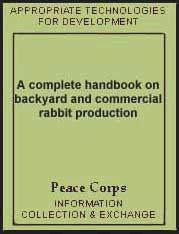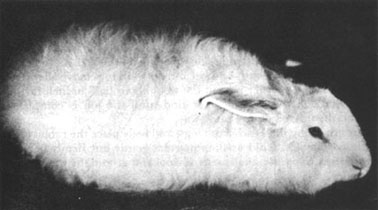
Types of production[edit | edit source]
Fryer production[edit | edit source]
A fryer or young rabbit carcass usually weighs not less than 1.7 kilos and should be from 3½-4 months old so that the pelt is of prime quality to warrant tanning.
A kilo of marketable fryer (dressed weight) will need 5.7 kilos of commercial concentrates from birth to marketing age. It takes about 82. 8 kilos of commercial concentrates to sustain a doe and her litter of 6 - 8, from breeding of the doe to marketing of the young at 3½-4 months of age. This is in addition to roughage and root crops given daily (about 1-1½ kilos total per day).
At 45 days to 2½ months, the bunnies are weaned from the doe and separated by sexes to allow for the next breeding. If the young are kept with the doe for over 2½ months, her milk supply will diminish to a level where the next kindling would not have a sufficient quantity.
Learn to castrate the bucks that are not intended for breeding stock to insure less quarreling amongst the bunnies held in colony. Castration demands much time, skill, and patience but, it is the only method to insure top quality meat and fur. It also maximizes space and feed.
Growth from 1 day to 2 months old is extremely fast so, be sure to give enough good quality feed in both roughage and concentrates to insure proper development.
Breeder production[edit | edit source]
Breeder production is similar to fryer production. Breeders should be obtained from good producing does and have excellent looks, good performance, docile personalities, good conformation such as stocky body, stub nose, short ears, and alert eyes and be excellent consumers of feed.
Since these will be used as breeding stock, special care must be given to their diet because negligence will result in deterioration, thus, propagating undesirable traits for generations to come. Select the future breeders as early as one month old.
Secure initial breeding stock from RELIABLE farms where records are available for your analysis. In the absence of records, utilize the observation signs listed above to determine breeder quality. In the long run, it will pay to purchase the better quality breeder rather than the less expensive one that does not meet the recommended observation signs of breeder quality.
Roaster production[edit | edit source]
A roaster or mature rabbit is a mature or old domestic rabbit carcass of any weight and has usually outgrown its productivity. You can fatten a roaster in 2 or 3 weeks to allow him to gain weight and improve fur quality.
It is doubtful if such production would be more profitable than that of rabbits of fryer weight.
Angora rabbit wool production[edit | edit source]
Angora rabbits are raised primarily for wool production (Fig. 28). In the Philippines this industry has not yet been developed although it is waiting for exploitation by any venturesome individual. The highlands: i.e. cooler climate, is the most conducive to raising this breed of rabbit.
FIGURE 28 - Angora rabbit.
Angoras grow to a length of.0625 m. to.0875 each 3 months, or approximately.025 per month. You can shear 14 to 15 ounces of wool a year from a mature Angora that is not nursing young. This wool is valued for its softness, warmth, and strength. It is used in blends with other fibers in the manufacture of children's clothing, sport clothes, garment trimmings, etc. Used alone it is usually too light and fluffy, besides, blends create better tensile strength and durability.
There are two main types of Angora rabbits - the English and the French. Present standards of the American Rabbit Breeders Association, however, make English and French types of wool synonymous. It is difficult to distinguish the English Angora rabbits from the French when they are cross-bred. The choice is largely a matter of personal preference. The typical French Angora usually is larger than the English. The wool fiber of the French is shorter and coarser than that of the English, but the wool yield is greater. Due to competition with other natural and synthetic fibers and competition with imported Angora rabbit wool, the market price is generally low. Therefore, it is advisable to use the Angora as a TRIPLE PURPOSE ANIMAL for meat, for improvement of fur quality of other breeds by cross breeding, which is presently being undertaken, and for wool production. Cross breeding Angoras with other breeds has proven beneficial both for better meat and fur production. The commercial Angora weighs at least 8 pounds and is being bred more and more to improve its meat quality.
Keep herd bucks and does in individual hutches. Keep woolers - does and castrated bucks maintained primarily for wool production - in groups or colonies to save labor. Castration of bucks that are to be reserved for wool production may reduce fighting in the herd but wool production is not increased by castration.
Feed and care for Angoras is the same as for other breeds. Because of their long wool, however, you must handle Angoras to find out how much flesh they are carrying; determine the amount of flesh by running the hand along the backbone. Reduce or increase the quantity of feed to keep the animal in healthy condition.
Angoras are generally sheared or plucked every 10 to 11 weeks though some producers pluck their animals monthly and some at intervals beyond 3 months.
Wool should be harvested prior to breeding to prevent mauling and soiling the wool.
To prevent internal parasite infestation and to keep wool clean (i.e. unstained by urine, etc.), install wire mesh floors in the pens and CLEAN DAILY.
A properly constructed manger for grass and legumes, or the use of a hopper, protects the wool from foreign matter and prevents contamination of feed. It is to be noted, however, that it is harder to breed Angoras than other breeds because of the concealment of their genitals due to the length of fur. The caretaker needs to assist in mating by holding the doe's tail upward while the buck mounts.
You will need the following equipment for grooming and shearing:
- A table, waist-high, with a.30 x.60 top covered with carpet or a feed sack to keep the rabbit from slipping and equipped with castors to allow easy turning. A table equipped with straps or cords for restraining the rabbit is advantageous.
- A hairbrush with single steel bristles set in rubber, for brushing and removing foreign material from wool.
- A pair of barber's scissors.
- A ruler for measuring the length of wool.
- Containers for storing wool.
Grooming[edit | edit source]
Commercial woofers require little, if any, grooming between shearing provided they are properly cared for and sheared every 10 to 12 weeks. If you allow the coat to grow for a longer period, the fibers may become webbed, tangled, or matted.
For grooming, place the rabbit on the table. Part the wool down the middle of the back. Brush one side, stroking downward. As you reach the end of the wool, brush upward and outward to remove all foreign material. Make another part in the wool about half an inch farther down the side. Repeat the operation until the job is completed. Groom the other side the same way.
For grooming the head, front legs, and belly place the rabbit on its back in your lap. Hold its hindquarters gently but firmly between your knees. Separate small areas of wool and groom the way you did the sides.
For grooming the hind legs, place the rabbit on its back in your lap. Hold the head and front feet under the left arm. Use your left hand to hold the rabbit's hind legs.
Shearing[edit | edit source]
Before shearing, cut off all stained ends of wool. Place the back of the scissors against the rabbit's body to prevent cutting the skin. Begin at the rump and shear a strip about an inch wide to the neck. Repeat this operation until you have removed all the wool from one side. Turn the rabbit around and repeat the shearing operation on the other side, starting at the neck and shearing toward the rump. For shearing the head, front legs, belly, and hind legs, restrain the rabbit as for grooming. Separate small areas of wool and shear the way you did the sides. Do not injure the doe's teats. Do not shear wool from the belly of a pregnant doe. After shearing, lightly brush the rabbit to straighten out the wool fibers and prevent the formation of mats. Take care not to include the flesh while shearing.
Grading, preparing, and marketing wool[edit | edit source]
Lable a container for each grade of wool and place it near the shearing table. Grade the wool as sheared, following the usual commercial grades.
Plucked wool:
Super -.0825 or longer
No. 1 -.075 or longer
No. 2 -.05 or longer
Sheared wool:
No. 1 -.057 to.075
No. 2 -.038 to.05
No. 3 -.025 to.038
Shorts -.0125 to.019 (may be slightly webbed)
No. 4 - Matted
No. 5 - Stained and unclean
While the above have been the usually acceptable commercial grades for Angora rabbit wool, some grading systems have been simplified to the extent that only three grades are considered: No. 1 - clean wool; No. 2 - clean mats; and No. 3 - all other wool, including soiled wool.
Put each grade in a separate paper bag not too tightly packed. Tie the bags and place them in sacks or corrugated boxes for shipment.
If the wool is to be stored, store it in a dry place. To protect the wool from moths, put mothballs or moth crystals in a small sack before placing this in the container with the wool.
Some Angora breeders spin the wool on an old-fashioned spinning wheel and knit the yarn into garments for home use or for sale. Others sell the wool to organizations or individuals who collect large quantities for sale to mills.
Rabbit wool production needs to be developed in the Philippines. We included Angora wool production in this handbook, specifically, for future reference of any innovative individuals.
